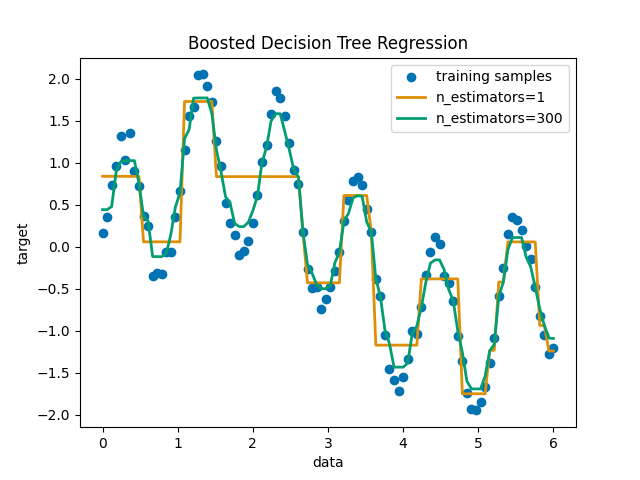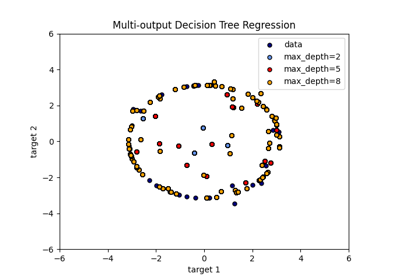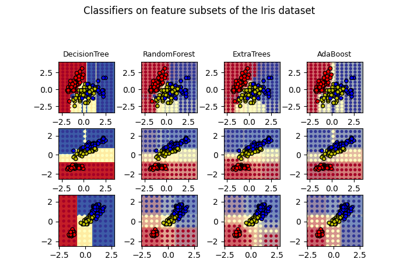Note
Go to the end to download the full example code. or to run this example in your browser via Binder
AdaBoost 决策树回归#
在带有少量高斯噪声的一维正弦数据集上,使用 AdaBoost.R2 [1] 算法对决策树进行提升。 将 299 次提升(300 棵决策树)与单个决策树回归器进行比较。随着提升次数的增加,回归器可以拟合更多细节。
请参阅 直方图梯度提升树的特性 以了解使用更高效回归模型(如 HistGradientBoostingRegressor )的好处。
准备数据#
首先,我们准备具有正弦关系和一些高斯噪声的虚拟数据。
# 作者:scikit-learn 开发者
# SPDX许可证标识符:BSD-3-Clause
import numpy as np
rng = np.random.RandomState(1)
X = np.linspace(0, 6, 100)[:, np.newaxis]
y = np.sin(X).ravel() + np.sin(6 * X).ravel() + rng.normal(0, 0.1, X.shape[0])
训练和预测使用决策树和AdaBoost回归器#
现在,我们定义分类器并将它们拟合到数据上。
然后我们在相同的数据上进行预测,以查看它们的拟合效果。
第一个回归器是一个 max_depth=4 的 DecisionTreeRegressor 。
第二个回归器是一个以 max_depth=4 的 DecisionTreeRegressor 为基础学习器的 AdaBoostRegressor ,
并将使用 n_estimators=300 个这样的基础学习器进行构建。
from sklearn.ensemble import AdaBoostRegressor
from sklearn.tree import DecisionTreeRegressor
regr_1 = DecisionTreeRegressor(max_depth=4)
regr_2 = AdaBoostRegressor(
DecisionTreeRegressor(max_depth=4), n_estimators=300, random_state=rng
)
regr_1.fit(X, y)
regr_2.fit(X, y)
y_1 = regr_1.predict(X)
y_2 = regr_2.predict(X)
绘制结果#
最后,我们绘制了两个回归器(单一决策树回归器和AdaBoost回归器)拟合数据的效果。
import matplotlib.pyplot as plt
import seaborn as sns
colors = sns.color_palette("colorblind")
plt.figure()
plt.scatter(X, y, color=colors[0], label="training samples")
plt.plot(X, y_1, color=colors[1], label="n_estimators=1", linewidth=2)
plt.plot(X, y_2, color=colors[2], label="n_estimators=300", linewidth=2)
plt.xlabel("data")
plt.ylabel("target")
plt.title("Boosted Decision Tree Regression")
plt.legend()
plt.show()

Total running time of the script: (0 minutes 0.197 seconds)
Related examples





